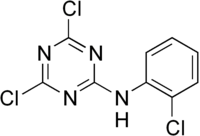Anilazine
Appearance

| |

| |
| Names | |
|---|---|
| Preferred IUPAC name
4,6-Dichloro-N-(2-chlorophenyl)-1,3,5-triazin-2-amine | |
| Other names
Anilazine (Dyrene);
dyrene
| |
| Identifiers | |
3D model (JSmol)
|
|
| ChEMBL | |
| ChemSpider | |
| ECHA InfoCard | 100.002.646 |
| EC Number |
|
| KEGG | |
PubChem CID
|
|
| RTECS number |
|
| UNII | |
| UN number | 3077, 2588 |
CompTox Dashboard (EPA)
|
|
| |
| |
| Properties | |
| C9H5Cl3N4 | |
| Molar mass | 275.52 g·mol−1 |
| Appearance | White to light brown crystals or powder |
| Density | 1.611 g/cm3 |
| Melting point | 159 °C (318 °F; 432 K) |
| Boiling point | 365 °C (689 °F; 638 K) |
| 0.0008 g/100mL | |
| Solubility | hexane: .017 g/100 mL methylene chloride: 9 g/100 mL acetone: 10 g/100 mL chlorobenzene: 6 g/100 mL toluene: 5 g/100 mL xylene: 4 g/100 mL |
| Vapor pressure | 2.48x10−5 mmHg |
| Hazards | |
| GHS labelling: | |
  
| |
| Danger | |
| H315, H318, H319, H410 | |
| P264, P273, P280, P302+P352, P305+P351+P338, P310, P321, P332+P313, P337+P313, P362, P391, P501 | |
| Flash point | 232.2 °C (450.0 °F; 505.3 K) |
| Lethal dose or concentration (LD, LC): | |
LD50 (median dose)
|
>5,000 mg/kg |
Except where otherwise noted, data are given for materials in their standard state (at 25 °C [77 °F], 100 kPa).
| |
Anilazine (ǎ-nǐl-a-zēn) is an organic compound with the chemical formula C9H5Cl3N4. It is a pesticide used on crops. It comes under the category of triazine fungicides. It is used for controlling fungus diseases which attack lawns and turf, cereals, coffee, and a wide variety of vegetables and other crops. It is also used for the control of potato and tomato leafspots.
Toxicity
[edit]Oral administration to rats and cats, the most common signs of toxicity were diarrhea and vomiting respectively After dermal administration to rabbits mild skin irritation manifested as edema and erythema was observed. Anilazine was more toxic by intraperitoneal injection than by other routes of administration.[1]
Medical use
[edit]In 1955, Bergsmann studied dairin as a tuberculocide.[2]
References
[edit]- ^ IPCS InChem document
- ^ BERGSMANN O (1955). "A report on the clinical application of dairin, a tuberculocide". Die Medizinische (29–30): 1053–5. PMID 13253229.
External links
[edit]- Anilazine in the Pesticide Properties DataBase (PPDB)
